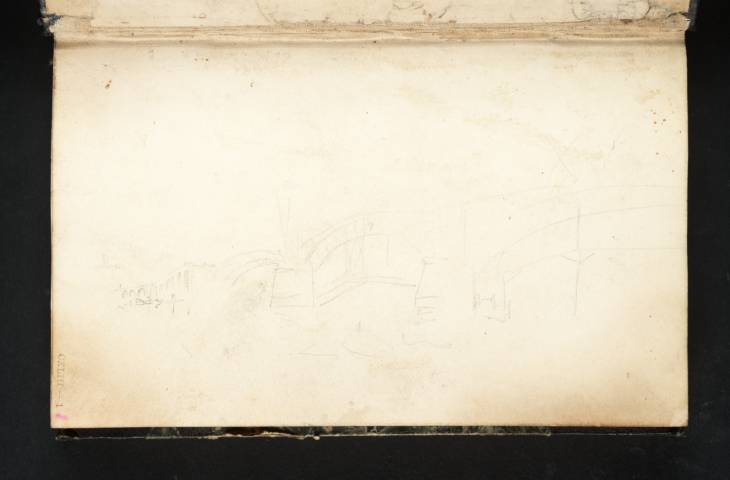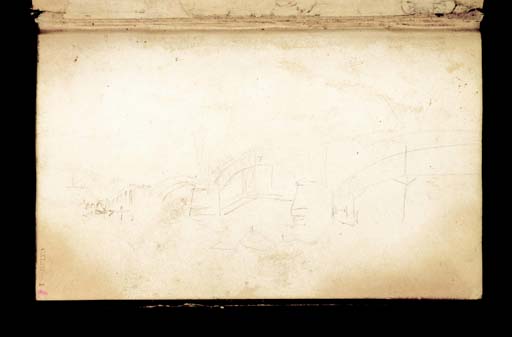Joseph Mallord William Turner Southwark Bridge under Construction c.1815-16
Image 1 of 2
Joseph Mallord William Turner,
Southwark Bridge under Construction
c.1815-16
Joseph Mallord William Turner 1775–1851
Folio 1 Recto:
Southwark Bridge under Construction c.1815–16
D10775
Turner Bequest CXLIII 1
Turner Bequest CXLIII 1
Pencil on white wove paper, 102 x 160 mm
Partial watermark ‘een | 14’
Inscribed by Turner in pencil ‘7’ at centre of bridge
Inscribed by John Ruskin in red ink ‘1’ bottom left, descending vertically
Stamped in black ‘CXLIII – 1’ bottom left, descending vertically (now smudged and faint)
Partial watermark ‘een | 14’
Inscribed by Turner in pencil ‘7’ at centre of bridge
Inscribed by John Ruskin in red ink ‘1’ bottom left, descending vertically
Stamped in black ‘CXLIII – 1’ bottom left, descending vertically (now smudged and faint)
Accepted by the nation as part of the Turner Bequest 1856
References
1909
A.J. Finberg, A Complete Inventory of the Drawings of the Turner Bequest, London 1909, vol.I, p.411, CXLIII 1, as ‘An iron bridge with stone supports. ? The railway bridge over the Thames at Richmond’.
1966
Jack Lindsay, J.M.W. Turner: His Life and Work: A Critical Biography, London 1966, p.255.
Finberg’s suggestion1 that the subject, drawn with the page turned horizontally, is the railway bridge over the Thames between Richmond and Twickenham is incorrect. (There is a superficial formal similarity in the wide, shallow arches, but details differ and anyway that bridge dates from 1848, towards the very end of Turner’s life. It was reconstructed along similar lines in 1908.2) Instead, Southwark Bridge is shown; its construction was agreed in 1811, with preliminary work beginning in 1813, about a quarter of a mile upstream on the Thames from London Bridge, somewhat further downstream from Blackfriars Bridge, and about midway between St Paul’s Cathedral on the north bank and Southwark Cathedral on the south. Designed by John Rennie the elder (1761–1821), it comprised three main cast-iron spans of sixty-four, seventy-three and sixty-four metres, between stone piers constructed on timber platforms. The first stone was laid in April 1815 and the bridge was opened in 1819;3 it was later entirely rebuilt, opening in 1921 in its present form,4 and is now flanked by the Millennium Bridge upstream and Cannon Street Railway Bridge downstream.
Looking westwards up the river, Turner’s viewpoint is on or near the north bank; the arcade below the site of the tollhouses on the south side is seen in the distance, as shown completed in an 1828 wash drawing by John Chessell Buckler (London Metropolitan Archives). There are related studies on the verso and folio 2 recto (D10776, D10777). Jack Lindsay noted this sketch among examples of Turner’s ‘eye for labour processes’;5 both here and on folio 2 recto, where the bridge is seen head on rather than in perspective, Turner has recorded cranes and the falsework or centrings supporting the construction of the arches, also seen in an anonymous etching of about 1815 and another after Frederick Nash of 1818, and in a drawing by John Taylor, dated 1817 (all London Metropolitan Archives).
See ‘Richmond Railway Bridge, River Thames’, geograph, accessed 30 March 2011, http://www.geograph.org.uk/photo/615552 .
See ‘Old Southwark Bridge’, Southwark Bridge, accessed 30 March 2011, http://www.southwarkbridge.co.uk/history/old-southwark-bridge.htm .
See ‘Southwark Bridge’, ibid., accessed 30 March 2011, http://www.southwarkbridge.co.uk/map/southwark-bridge.htm .
Technical notes:
There is some staining and mottling, offset from the front pastedown opposite (D40870).
Matthew Imms
September 2013
How to cite
Matthew Imms, ‘Southwark Bridge under Construction c.1815–16 by Joseph Mallord William Turner’, catalogue entry, September 2013, in David Blayney Brown (ed.), J.M.W. Turner: Sketchbooks, Drawings and Watercolours, Tate Research Publication, September 2014, https://www


